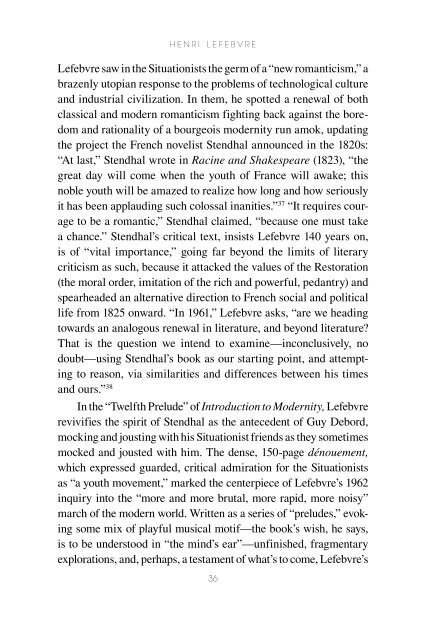Henri Lefebvre: A Critical Introduction - autonomous learning
Henri Lefebvre: A Critical Introduction - autonomous learning
Henri Lefebvre: A Critical Introduction - autonomous learning
You also want an ePaper? Increase the reach of your titles
YUMPU automatically turns print PDFs into web optimized ePapers that Google loves.
H e n r i L e F e b v r e<br />
<strong>Lefebvre</strong> saw in the Situationists the germ of a “new romanticism,” a<br />
brazenly utopian response to the problems of technological culture<br />
and industrial civilization. In them, he spotted a renewal of both<br />
classical and modern romanticism fighting back against the boredom<br />
and rationality of a bourgeois modernity run amok, updating<br />
the project the French novelist Stendhal announced in the 1820s:<br />
“At last,” Stendhal wrote in Racine and Shakespeare (1823), “the<br />
great day will come when the youth of France will awake; this<br />
noble youth will be amazed to realize how long and how seriously<br />
it has been applauding such colossal inanities.” 37 “It requires courage<br />
to be a romantic,” Stendhal claimed, “because one must take<br />
a chance.” Stendhal’s critical text, insists <strong>Lefebvre</strong> 140 years on,<br />
is of “vital importance,” going far beyond the limits of literary<br />
criticism as such, because it attacked the values of the Restoration<br />
(the moral order, imitation of the rich and powerful, pedantry) and<br />
spearheaded an alternative direction to French social and political<br />
life from 1825 onward. “In 1961,” <strong>Lefebvre</strong> asks, “are we heading<br />
towards an analogous renewal in literature, and beyond literature?<br />
That is the question we intend to examine—inconclusively, no<br />
doubt—using Stendhal’s book as our starting point, and attempting<br />
to reason, via similarities and differences between his times<br />
and ours.” 38<br />
In the “Twelfth Prelude” of <strong>Introduction</strong> to Modernity, <strong>Lefebvre</strong><br />
revivifies the spirit of Stendhal as the antecedent of Guy Debord,<br />
mocking and jousting with his Situationist friends as they sometimes<br />
mocked and jousted with him. The dense, 150-page dénouement,<br />
which expressed guarded, critical admiration for the Situationists<br />
as “a youth movement,” marked the centerpiece of <strong>Lefebvre</strong>’s 1962<br />
inquiry into the “more and more brutal, more rapid, more noisy”<br />
march of the modern world. Written as a series of “preludes,” evoking<br />
some mix of playful musical motif—the book’s wish, he says,<br />
is to be understood in “the mind’s ear”—unfinished, fragmentary<br />
explorations, and, perhaps, a testament of what’s to come, <strong>Lefebvre</strong>’s<br />
36
















